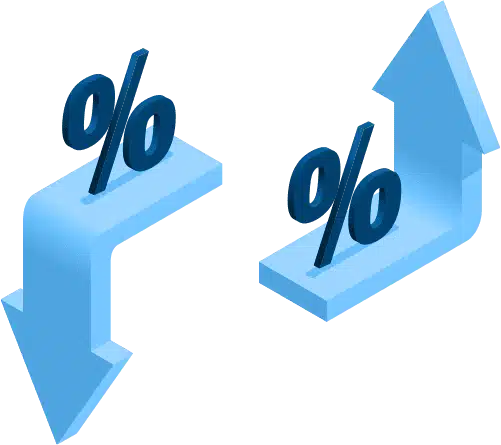Interest Rates

- What are Interest Rates?
- How to Calculate the Interest Rates?
- Simple Interest vs. Compound Interest
- Nominal, Real, and Effective Interest Rates
- How Interest Rates Affect the Economy?
- How to Trade on Interest Rate Decisions?
- Key Interest Rate Decisions Around the World
Every country around the world strives to create the best economic conditions and provide financial security to their citizens. However, the unpredictable nature of the global economy and politics often cause disadvantageous shifts. As the captain of the national economy, the central bank steers the country in economic storms. Interest rates are the sails of this economic boat, and the central banks are responsible for deciding where to set the sails as the economic climate changes.
See a trading opportunity? Open an account now!
What are Interest Rates?
An interest rate is the cost of borrowing a loan charged by the lender to the borrower. It is expressed as a percentage of the loan amount, known as the principle, and charged periodically depending on the specifications of the borrowing contract. The principle is the compensation the lender receives for taking the risk of being unpaid at the contract expiration.
Lenders determine the interest rate they will charge on the loan based on several risk factors. As the riskiness of particular loan increases, its interest rate will also increase:
- Borrower Risk: the potential of the borrower to fail to repay the debt
- Collateral: whether the loan repayment is secured with collateral like a property
- Inflation Rate: rising inflation would render the agreed interest rate less valuable
- Contract Duration: longer contracts are exposed to borrower and inflation risks longer
- Funds Cost: the expenses of the lender to acquire the funds which were lent to borrower
National Interest Rates
As the lender of the national currency, the minimum interest rate in a country is decided by its central bank. Functionally, the central bank generates income for the national treasury by lending to commercial banks and charging interest.
When the central bank raises or cuts the interest rates, other banks’ borrowing costs are affected. In turn, they reflect it on their own customers by applying higher or lower rates in their own commercial and retail financial services.
Central banks use interest rate decisions to control the currency value and navigate the economy towards the monetary policy goals such as low unemployment, high Gross Domestic Product (GDP) and a stable inflation rate.
How to Calculate the Interest Rates?
The interest rate level shows the cost of borrowing from the central bank. When the central bank lowers the interest rates, the commercial banks can borrow at cheaper rates. Business and private loans will become more accessible and stimulate the economy. In the opposite scenario, all parties would refrain from getting loans, and the economic activity would be slowed down.
Simple Interest vs. Compound Interest
Simple Interest is a fixed commission structure based on the initial loan amount. Compound Interest is an accumulating commission structure, in which the base loan amount grows in each period to include the interests of previous periods.
Let’s say an individual borrows $10,000 with an annual interest rate of 10% with 36-month expiry. If the contract is based on simple interest, the cost would be $1,000 for each year, and the total cost would be $3,000 for a $10,000 loan.
However, if it is based on compound interest:
- the interest of the 1st year would be 10% of the amount = $1,000
- the interest of the 2nd year would be 10% of the total of the 1st year ($11,000) = $1,100
- in the last year, it would rise to 15% of the first two years’ total ($12,100) = $1,210
- As a result, the total interest cost of the $10,000 loan would be $3,310 for the borrower.
Nominal, Real, and Effective Interest Rates
Nominal Interest Rate
As the duration of the loan increases, the actual value of the interest earnings can drop. If the economy is expanding and the inflation is rising, 3 years later the actual value of the $10,000 would be lower in terms of its purchasing power. However, the lender would be earning the interest rate according to the value of 3 years ago – this is known as the Nominal Interest Rate.
Real Interest Rate
When the nominal interest rate is adjusted to account for the inflation, it gives the Real Interest Rate. For example, if the inflation rate was at 3% when the 36-months loan of $10,000 was given with 10% interest rate, and the inflation is at 5% at the end of the contract, the real rate would be 8% when accounted for the 2% rise in the inflation.
Effective Interest Rate
The effective interest rate is used when calculating the nominal interest rate for compound interest loans. In other words, it is a nominal interest rate which accounts for the compound factor.
Effective Interest Rate = [(1 + (i / n) ^ n) – 1] x 100
- i: interest rate
- n: compound period
Let’s say a bank lends $10,000 at 10% annual nominal interest rate with a quarterly compound. The effective interest rate = [(1 + (10% / 4) ^ 4) – 1] x 100 = 10.38%. In other words, when the nominal 10% interest rate is adjusted for the compound period, the bank would effectively earn 10.38% interest on the $10,000 loan.
How Interest Rates Affect the Economy?
Interest rates are the main tools of the central banks to control the national economy. The primary goal is to facilitate optimum economic conditions in accordance with the monetary policy goals. Ideally, the central bank would strive to maintain 4% inflation, 3% GDP growth, and 4% unemployment on average to achieve steady economic growth. However, if the conditions are getting out of control, inflation especially, the central bank can hike or cut the interest rates to manipulate the money supply and stimulate or harness the economy.
Interest Rates in Expansionary & Contractionary Economic Policies
When the economy is stagnant or recessing, the central bank can adopt an expansionary monetary policy and stimulate the economy with an interest rate cut. Cheaper borrowing costs will reduce the interest rates the banks apply to their financial products. Thus, companies can get low-cost loans and invest in expanding their business and workforce. Increased business activity would add value to GDP, while reduced unemployment would increase the purchasing power. As a result, consumer demand would rise and cause inflation in the local prices.
However, sustained expansionary policy can hyperinflate market prices. Employees would be forced to demand higher salaries to maintain their standard of living. Businesses wouldn’t be able to afford both expansion and large workforces and start laying off people to remain profitable. Slowing production would bring GDP lower while rising unemployment inhibits the performance of the consumption economy.
In order to prevent this from happening and keep expansionary policies under control, the central bank can decide an interest rate hike and reduce the money supply in the domestic economy. Costlier loans would discourage businesses and individuals from spending and reduce demand. As the supply/demand ratio skews towards excessive supply, the local prices would decrease, and inflation would be kept in check.
Discount Rate vs. Federal Funds Rate
In the U.S. and several other major economies, the central banks can set different interest rates for central bank loans and interbank loans. The interest rate of borrowing from the central bank is known as the discount rate, while the interest rate on interbank loans is called the federal funds rate.
The federal funds rate is usually lower than the discount rate to encourage commercial banks to get loans from each other before applying for state loans. When the central bank is the lender, the loan is funded either from the national reserves or by printing money. Since the central bank would be manipulating the money supply, it can have a strong impact on the currency value.
How to Trade with Interest Rate Decisions?
Interest rates are lagging economic indicators of the economy. The decisions on the interest rates are based on the analysis of past data of other economic reports. Identifying the recent economic trends, the central bank can make projections and decide to set the interest rates higher or lower or keep them as they are.
Interest rate decisions are usually announced on a monthly basis or at six-week intervals. Sometimes, a press conference follows explaining the interest rate decision as well as other monetary policy decisions taken. Also, from time to time, emergency interest rate changes can occur, meaning central banks alter the interest rate level between the scheduled meetings.
Interest Rate Hikes & Cuts
Interest rate hikes are considered as a hawkish approach by the central bank. When the interest rates rise, the price of borrowing the national currency also rises. Lending becomes more profitable, and loans become more costly. Consequently, the national currency gains value in the foreign exchange markets. Rising interest rates would also affect other markets. The profitability of safer investments like bonds and treasury notes would increase, and the investors would redirect their capital to these options instead of riskier choices like stocks and indices.
Interest rate cuts are considered as a dovish approach by the central bank. When the interest rates fall, the price of borrowing the national currency also falls. Loans become cheaper, and lending becomes less profitable. As a result, the national currency loses value in the foreign exchange markets. Contrary to higher rates, the interest paying investments lose their appeal when the central bank cuts the interest rates. Investors would become more willing to assume the risks of stock markets to increase portfolio profitability.
Market Reactions
Let’s say that the U.S. Federal Reserve to announce interest rate decision and analysts forecast a 0.25% decrease. The market sentiment already incorporates the decision during the day, and USD pairs gain downwards momentum. The Fed delivers the interest cut and a dovish statement about future rates, the USD will drop significantly. If the cut were higher than usual, like 0.50% instead of 0.25%, the market turmoil would sink the U.S. Dollar. On the other hand, if the rates were kept as they are, the investors would quickly buy back USD and shoot it back to the top.
Interest rates, therefore, provide opportunities to speculate on the rise or fall of a currency, but also to invest based on fundamental analysis and expected changes. They create opportunities but also risks due to the increase in market volatility.
For news trading strategies, everything surrounding the interest rate matters the most. In fact, the purpose of interpreting all the economic releases (e.g., GDP, CPI, unemployment) between two central bank meetings is to form an idea about what the central banks will do next with the interest rate level.
Key Interest Rate Decisions Around the World
U.S. Federal Fund Rates
- Region: North America
- Date of release: 8 times a year
- Issuing Agency: Federal Open Market Committee (FOMC) of the Federal Reserve (Fed)
- Affected Assets: USD; U.S. stocks and bonds; Dow Jones, US500, US_TECH100; USD-traded commodities
EU Official Interest Rates
- Region: Europe
- Date of release: 8 times a year
- Issuing Agency: European Central Bank (ECB)
- Affected Assets: EUR; EuroStoxx50; DAX 30, CAC 40; government bonds of EU-members
U.K. Base Rate
- Region: Europe
- Date of release: 8 times a year
- Issuing Agency: Monetary Policy Committee (MPC) of the Bank of England (BoE)
- Affected Assets: GBP, EUR; British stocks; FTSE 100; UK Gilts
Canada Policy Interest Rate
- Region: North America
- Date of release: 8 times a year
- Issuing Agency: Bank of Canada (BoC)
- Affected Assets: CAD; Canadian stocks; S&P/TSX; Canada Marketable Bonds; Crude Oil
Japan Interest Rates
- Region: Asia
- Date of release: 8 times a year
- Issuing Agency: Bank of Japan (BoJ)
- Affected Assets: JPY; Japanese stocks; Nikkei 225; Japan government bonds
China Base Interest Rate
- Region: Asia
- Date of release: 8 times a year
- Issuing Agency: People’s Bank of China (PBC)
- Affected Assets: CNY, AUD, NZD; Chinese stocks; China A50; Chinese Government Bonds
Australia Base Rate
- Region: Oceania, Asia
- Date of release: 8 times a year
- Issuing Agency: Reserve Bank of Australia (RBA)
- Affected Assets: AUD, NZD; Australian and New Zealand stocks and bonds; ASX 200 index
Why Trade Interest Rate Decisions with Friedberg Direct?
Interest rate decisions are one the most influential data releases. All markets – currencies, bonds, or stocks – react aggressively on interest rate changes, especially if they come as a surprise.
If you want to make the most out of them, equipping yourself with best trading tools with Friedberg Direct is beyond essential.
- When is the next Interest Rate Decision? Go to our economic calendar and see when the next U.S. Federal Reserve interest rate announcement is due, don’t forget to mark it in your calendar!
- A Wide Range of Assets: Key interest rates reports affect key assets; you can trade all interest-affected currency pairs, stocks, and indices with high leverage and low spreads.
- Long & Short CFD Trading: Whether Interest rate figure is positive or negative, we can trade CFDs to benefit from both rising and falling prices without having to purchase the assets! No restrictions on short selling apply.
- How can I predict the central bank’s decision? Interest rate decisions are affected by GDP, CPI and unemployment reports. Learn more about them and see how they performed since the last decision.
Now that you fully understand how Interest Rates work and affect the economy put your knowledge into action. Start by thinking what will the Fed and the ECB decide for their interest rates when the current economic conditions are considered.
See a trading opportunity? Open an account now!
** Disclaimer – While due research has been undertaken to compile the above content, it remains an informational and educational piece only. None of the content provided constitutes any form of investment advice.







